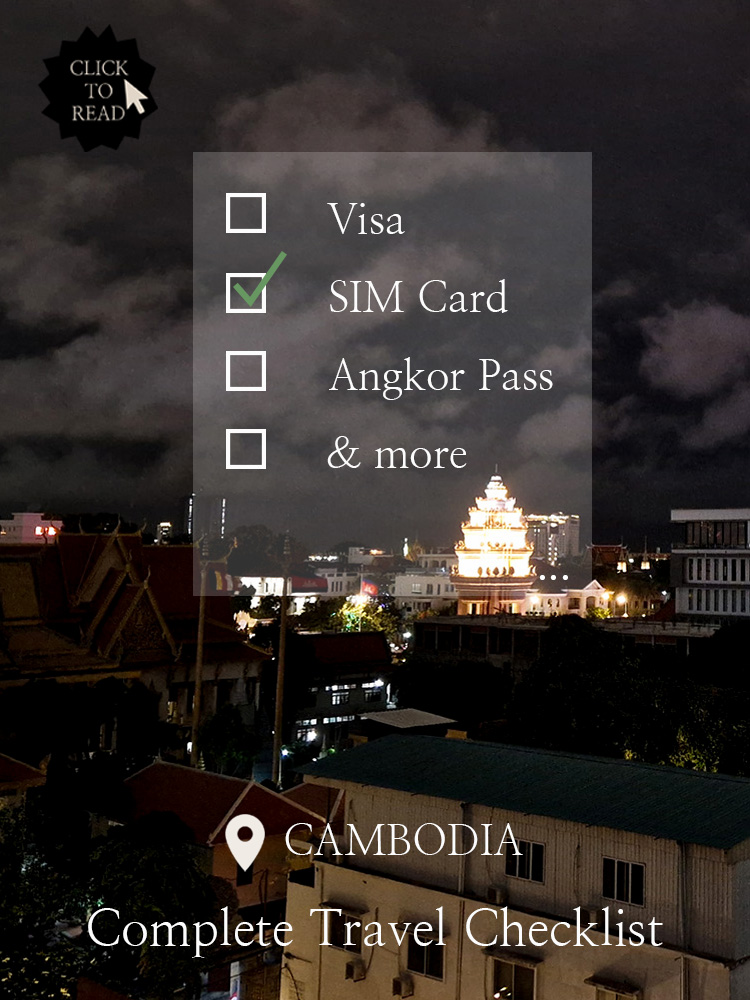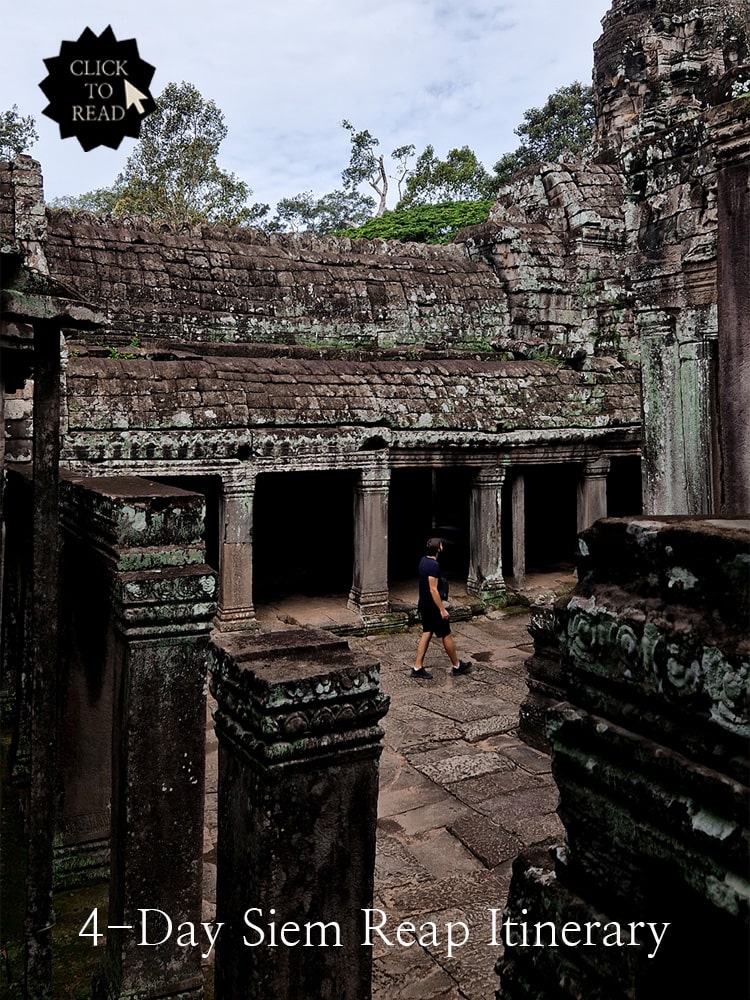Complete Guide to visiting Angkor Wat from Siem Reap – Everything you need to know when planning your visit
There is a very high chance that Angkor Wat is among your top 5 reasons, if it isn’t THE reason, why you decided to travel to Cambodia in the first place. And, truthfully, it is a very good one. Because visiting Angkor Wat is definitely a once in a lifetime experience!
In this complete Angkor Wat travel guide, we will go over all the planning details related to your visit to the Angkor Archaeological Park. How many days do you need? Where to get your entry pass? How to get around? Angkor Wat at sunrise, worth it or not? And so much more!
Note: This post may contain affiliate links. By interacting with these links, you can support us and our website at no extra cost to you🍀! Our affiliate links are marked by an *, so you can recognise them in advance. For more information, read our Disclaimer.
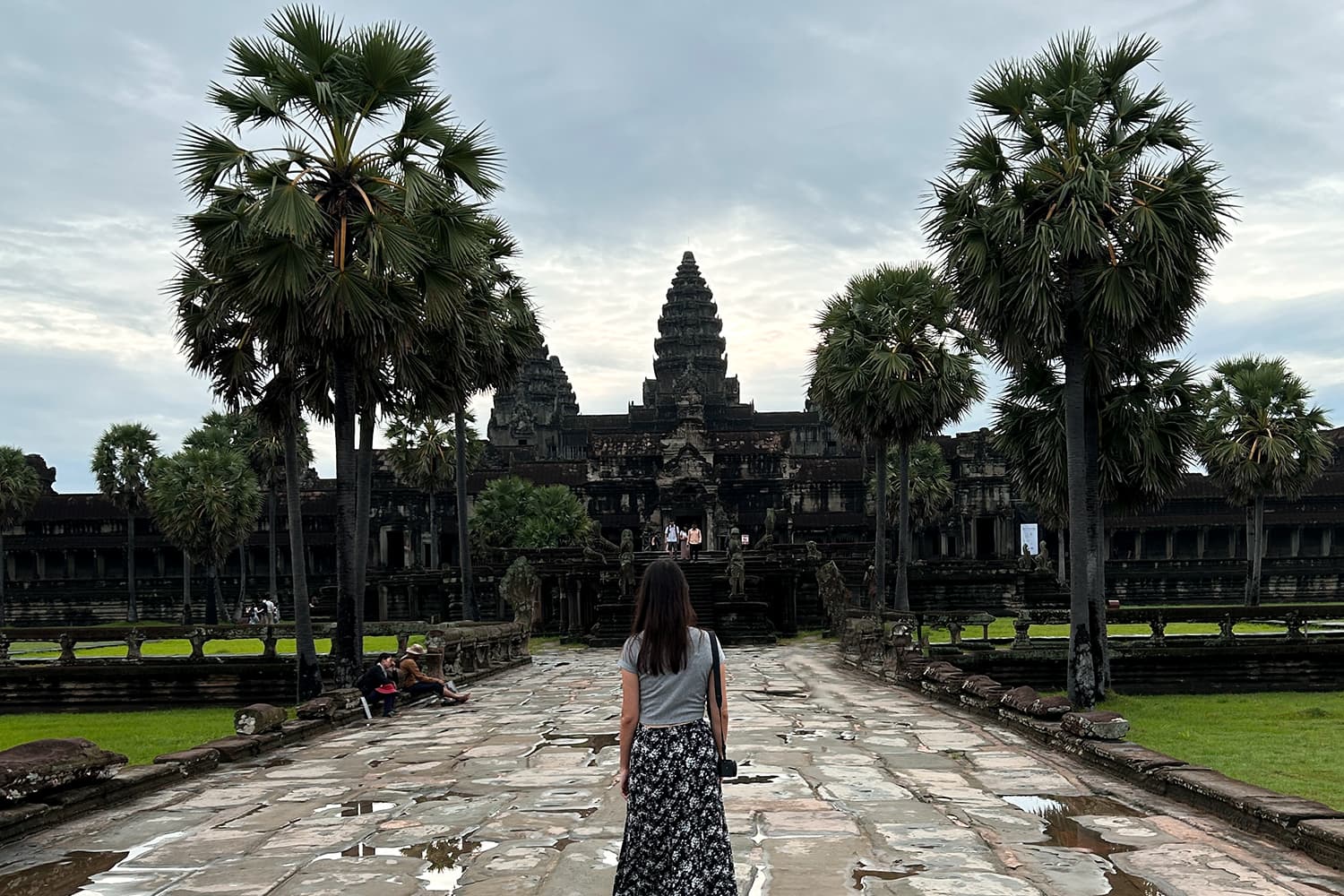
Ultimate Guide to visiting the Angkor Archaeological Park in Siem Reap
Visiting Angkor is a little more complicated than just showing up. For starters your ticket will be a personalised one, you will need to organise a tuk-tuk driver to take you around for one or multiple days as well as decide what sites you wish to visit and which to skip. Quite a lot of logistics to take care of as you can see.
But fret not. In this complete Angkor Wat guide, we will walk you through the steps of planning your trip to Angkor Wat (or more accurately the Angkor Archaeological Park) one at a time. And by the end, there is nothing standing in between you and a successful trip to Angkor! Except for maybe the weather, that, we can’t control😉.
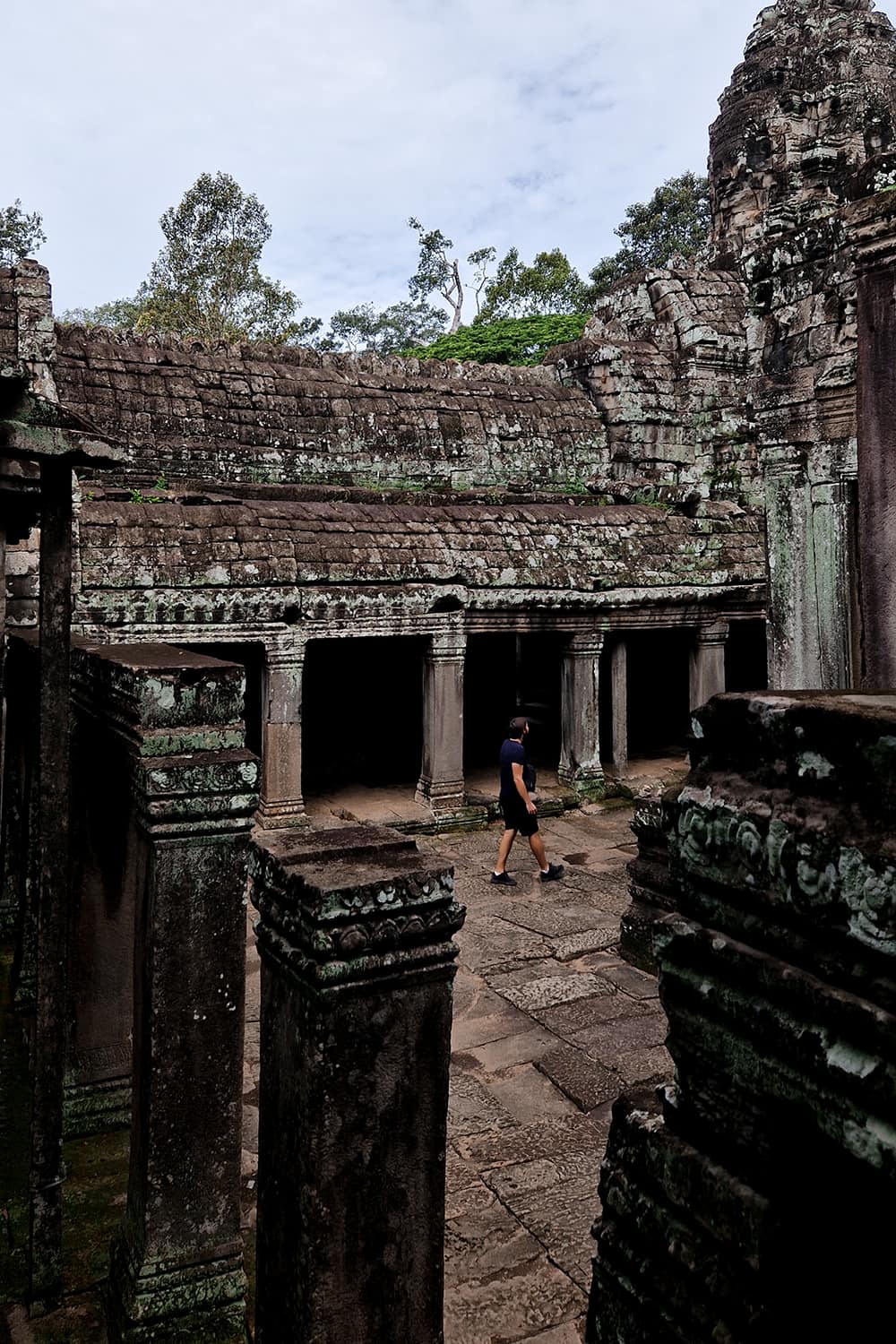


Did you know? You can find all our travel guides, itineraries and so much more on our dedicated Cambodia Travel Guide Page!
What exactly is Angkor Wat? And why visit?
But first, let’s start with a little history and a few stats.
When people talk about visiting Angkor Wat, what they actually refer to most of the time is the whole Angkor Archaeological Park. So, what’s the difference? Well, Angkor Wat itself is actually only one temple, albeit the most famous one, inside a quite frankly gigantic complex that is home to numerous temples and ruins.
Just to give you a better idea of the scope of things:
- the whole Angkor Archaeological Park stretches over 400 square kilometres,
- encompassing 50+ major and minor temples as well as numerous other impressive structures.
- The temple of Angkor Wat alone has a size of 160 hectares and is considered to be the world’s largest religious structure.


But, what is the origin of this gigantic complex? And who decided to built such impressive sites?
Well, in short, Angkor used to be a city from which the Khmer Empire was ruled. The latter was one of the largest and most sophisticated kingdoms in the history of mainland Southeast Asia. A lot of the construction projects that remain today were undertaken between the 9th and the 13th century by various kings of the Khmer Empire.
Know this when buying your Angkor Pass/Entry Ticket
The first thing you should take care of is your entry pass to the Angkor Archaeological Park. In this section, we will go over the details of purchasing your entry pass and what to watch out for while doing so.
🗺️ Where to best get your entry pass – online or on site?
There are two options for where you can obtain your Angkor entry pass. Either you purchase it on-site at the official ticket counter 4 kilometres outside of Siem Reap or on the official website online.
Personally, we would recommend buying your entry ticket online. Why?
- First of all, you don’t have to physically go to the ticket office, which is located quite far outside of Siem Reap.
- No waiting lines.
- When booking online, you get a digital ticket that you can simply present on your phone at the check point.
- If you intend to visit Angkor Wat at sunrise on your first day, having to first go and get a physical ticket might prove to be quite stressful or downright impossible, depending on the season you are visiting in and the crowds.
Note: When buying your ticket online, you cannot buy a ticket for the same day!

No matter what option you decide to go with, make sure that you only buy your ticket at the official ticket counters, which you can find down below.
Why only book on the official sites? Well, there are agencies you can book via, however they will most certainly charge you with some crazy amount of processing fees (e.g. on Viator a 1-Day Pass will cost you 59$ instead of 37$🫠). Also, there are a number of fake websites around. To mitigate all that, simply stick to the official sites.
Angkor Ticket Office (Angkor Enterprise)
- The only place where you can buy tickets on-site.
- Located on Street 60 (4 kilometres away from Siem Reap).

Angkor Enterprise Website
- Official government website for booking your Angkor Pass online. (Make sure it is the following URL: https://ticket.angkorenterprise.gov.kh)

💸 How much does entrance to the Angkor Archaeological Park cost?
When booking your entry ticket, you have three ticket options:
- 1-Day Pass for 37$,
- 3-Day Pass for 62$ or
- 7-Day Pass for 72$.
🌐 How to book your Angkor tickets online? A quick walkthrough
Booking your Angkor ticket online is actually very straight forward. You literally only have to follow the instructions given on the website.
- Step 1: Create an account via your E-Mail or sign in with your Google or Facebook Account.
- Step 2: Select the Angkor World Heritage Pass.
- Step 3: Select the type of ticket (i.e. 1, 3 or 7-Day Pass) and your preferred date of entry. Note: You can book max. 1 month in advance.
- Step 4: Fill in your visitor information (i.e. your Gender, Age and Nationality) and provide a photo where your face is the focus and easily recognisable. It does not have to be a professional passport photo, a clear picture taken on your phone will be enough.
- You can also add additional tickets here. If you travel as a couple or family, only one of you will have to make an account and can purchase tickets for the rest of your travel party.
- Step 5: Confirm your purchase and pay the ticket fees.


⌛ How long are your tickets valid?
- 1-Day Pass: valid for 5 days from the date you enter as entry date. Visit any 1 day within this time span.
- 3-Day Pass: valid for 10 days from the date you enter as entry date. Visit any 3 days within this time span.
- 7-Day Pass: valid for 30 days from the date you enter as entry date. Visit any 7 days within this time span.
How many days should you spend at Angkor?
This will depend on your Cambodia itinerary and how much time you have in Siem Reap. However, we would highly recommend planning at least 2 days, ideally 3 days specifically for exploring Angkor Archaeological Park.
Our recommendation:
Spend 4 days in Siem Reap, thereof 3 exploring the Angkor Archaeological Park! Want to know how? Find out more in our


How to get to Angkor from Siem Reap? And how to get around?
Angkor Wat is located a whole 7 kilometres away from Siem Reap city centre. From Angkor Wat to the famous Bayon Temple it is another 3 kilometres, from Bayon to Ta Phrom (the Tomb Raider) Temple another 5 kilometres and so on. I think you guessed where I am going with this: Exploring Angkor is not something you will be doing on foot.
So, what are your options?
- Either you can rent a motorbike or bicycle and go around on your own, or
- Hire a tuk-tuk driver to take you around.


Personally, we would recommend hiring a tuk-tuk driver. Why?
- First of all, if you hire a good tuk-tuk driver, he will provide you with information on the different temples and sights you will be visiting along the way. We were definitely able to appreciate Angkor so much more that way!
- However, our driver never visited the temples with us. That gave us the opportunity to explore at our own pace, which we very much appreciated. We got the best of both worlds in a sense: A guide that provided us with information, but also not really a guide that you would need to follow around😆.
- And finally, the livelihood of most tuk-tuk drivers depends on tourists and we think it is always good to support the locals wherever you visit.
Not sure how to navigate hiring tuk-tuk’s in Cambodia? Check out
Book the same driver we had!
We found our tuk-tuk driver for Angkor via Facebook and, truthfully, he simply was the best. We could not have wished for a better one!
- First of all, he was quite knowledgeable and told us much about Angkor as well as life in Siem Reap.
- He was our driver for 3 full days and came to pick us up at 4 a.m. in the morning on our last day to go see the sunrise at Angkor Wat!
- Every time we got back to the tuk-tuk after visiting a sight he waited for us with a bottle of water and cold wet towels to wrap around our wrist to battle the heat. The latter truly took a toll on us so we were very grateful.
- Also, he always warned us if there ever was something to watch out for.
So where can you find him? His name is Sok Menea and you can simply look him up on Facebook! If you want to be sure you got the right one, there is a picture of us with him on his page posted on the 12th October 2023😉.
Note: To give you a rough idea of prices, we paid 25$ per day for his services. This was in 2023.

Typical Sightseeing Routes: The Small Circuit and the Grand Circuit
After arranging your mode of transportation, the next planning stage consists in deciding what to see in Angkor Archaeological Park. There are a lot of sights. And, depending on how much time you have on your hands, you might need to prioritise. So what are the typical sightseeing routes? And what temples are worth it more than others? Let’s find out!
There are two common routes that tourists typically take to tick off the most popular sights: The Small Circuit and the Grand Circuit. As you can see on the map down below, both circuits partially overlap. For simplicity, we will treat the overlapping sites only once😉. The sights having a yellow pin on the map will be treated in the ‘Small Circuit’ section down below and the sights with a blue pin in the ‘Grand Circuit’ section.

🛺 The Small Circuit and its popular sites
Let’s start with the Small Circuit! The latter passes three of the most popular temples. And, what better way to start than with the most popular one among all of them:
📍 Angkor Wat
Built in the 12th century by Suryavarman II, originally as a Hindu temple that was later altered to become a Buddhist temple.
- Highlight: Honestly the whole structure. Angkor Wat has a size of 160 ha, which makes it the largest religious structure in the world!
- Worth a visit? Yes, Angkor Wat 100% deserves all the hype it gets. If you decide to only visit one site (which we wouldn’t recommend though), then Angkor Wat is definitely the one!

📍 Phnom Bakheng

Remains of a Hindu temple dedicated to Shiva that was built at the end of the 9th century.
- Highlight: Phnom Bakheng is built on a hill, which is why it gives you a bit of an overview over the forest encompassing the whole area. You can even see all the way to Angkor Wat which is located 1.5 km away! The latter makes it a popular spot among tourists for watching the sunset.
- Worth a visit? If you have the time to include Phnom Bakheng then yes, however it is not a must. Personally, we think it is more so worth it for the views than the temple remains itself.
📍 Tonle Om Gate (Southern Gate of Angkor Thom)
Angkor Thom (in grey on the map above) was established in the late 12th century and is considered to be the Khmer empire capital that lasted the longest, as it was only abandoned somewhere around 1600. It was originally built by Jayavarman VII.
Angkor Thom is surrounded by an 8-metres high wall around its perimeter that can only be entered though specific gates. The Southern Gate being one of them.
- Highlight: The gates are quite impressive and decorated with numerous fascinating statues and carved faces of mythical creatures and giants.
- Worth a visit? Yes, the gates leading into Angkor Thom are definitely worth a visit. However, you don’t really have to plan on visiting them since you will have to pass at least one of them, most likely the Southern one, when visiting Angkor Thom anyway!
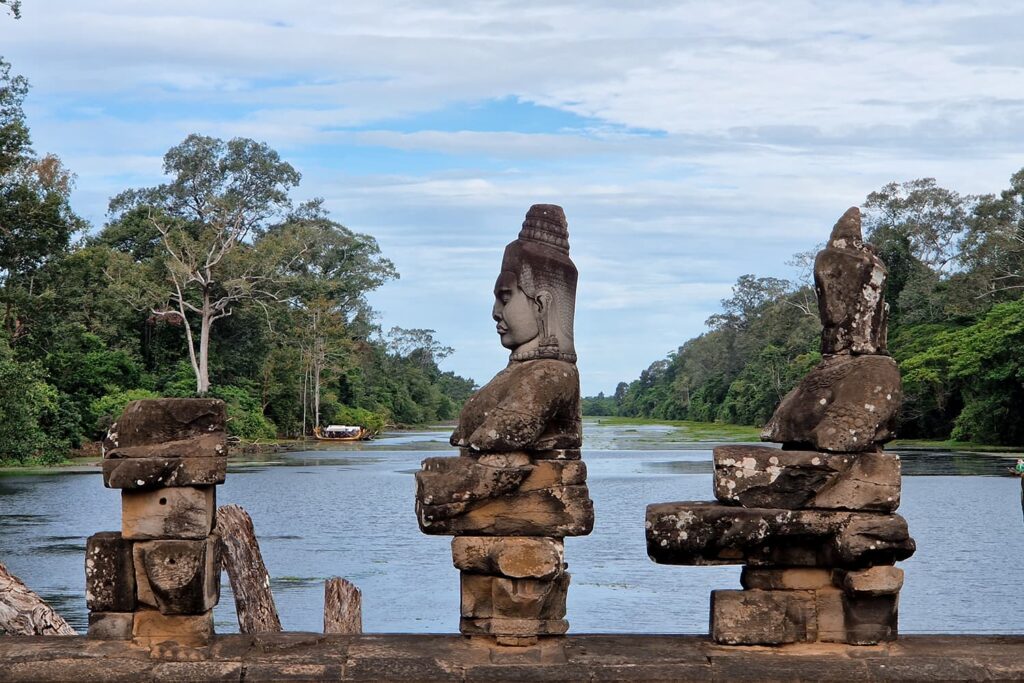

📍 Bayon

Bayon is a (mainly) Buddhist temple that sits exactly at the centre of Angkor Thom. Finished at the beginning of the 13th century, Bayon functioned as the state temple for Jayavarman VII, who, as mentioned before, was also the founder of Angkor Thom.
- Highlight: Bayon Temple is quite big and rather fun to explore as it is home to a number of impressive towers, beautiful statues and carvings.
- Worth a visit? Yes, Bayon is definitely worth a visit! After Angkor Wat, Bayon is for sure among the most frequented temples in Angkor Archaeological Park.
📍 Ta Keo
Completed at the end of the 10th century by Jayavarman V, this temple was constructed as a Hindu temple dedicated to Shiva. The pyramid-like layout of the temple is said to imitate Mount Meru, a mountain that holds significant importance in the Hindu (and Buddhist) cosmology.
- Highlight: Ta Keo is believed to be the first Khmer temple completely built in sandstone.
- Worth a visit? We ended up skipping Ta Keo so we can’t say for sure. Supposedly, while impressive, it is largely unadorned.

📍 Ta Phrom (featured in Tomb Raider)
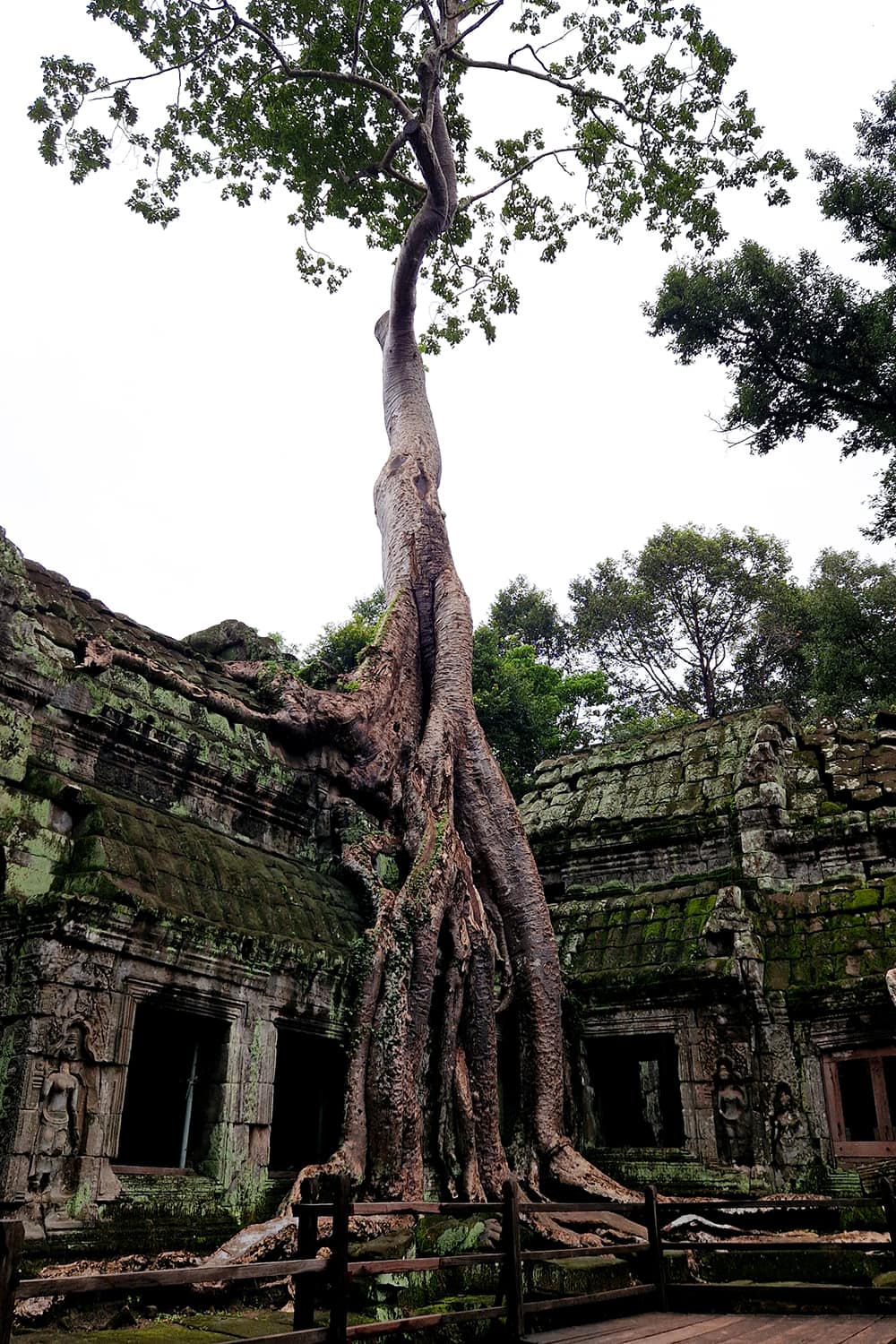
Ta Phrom was built in a very similar style to Bayon, which makes sense since it was also built by Jayavarman VII, and completed in the early 13th century. Today it is best known as the “Tomb Raider” temple since being featured in said movie in 2001.
- Highlight: The absolute highlight of this temple are the massive trees that have taken over Ta Phrom ever since it was abandoned. Stunning roots meander through the walls and form beautiful gates. It is truly a sight to behold!
- Worth a visit? If the highlight section didn’t imply enough: Yes, Ta Phrom is definitely worth a visit and truly deserving of the hype that it gets! I mean, just look at that tree growing on the Ta Phrom ruins in the picture!
📍 Banteay Kdei
Aaand, another temple built by Jayavarman VII😆. This one is also rather similar in style to, you guessed it, Bayon and Ta Phrom. However, it is less complex and smaller in size.
- Highlight: It tends to be less touristy than Bayon or Ta Phrom, while still having a similar feel to it.
- Worth a visit? If you visit during a quieter time of the year and have Bayon and Ta Phrom largely to yourself, then Banteay Kdei is not really a must and often skipped, which we did as well. During busier times it might be a worthwhile addition to your schedule if you are looking for a quieter temple.

🛺 The Grand Circuit and its popular sites
Even though the Small Circuit contains three of the most popular sites in Angkor, the Grand Circuit is also home to some really stunning structures, some we think would be an absolute shame to miss out on! So, let’s have a look!
📍 Baphuon
Baphuon was built in the mid-11th century by Suryavarman I, as a Hindu temple dedicated to Shiva, but was later transformed into a Buddhist temple. The layout of the temple imitates a mountain shape.
Baphuon is located inside Angkor Thom, even though the temple itself predates the existence of Jayavarman VII’s Khmer city.
- Highlight: There is a long stunning walkway leading up to the temple. Also, standing on top of Baphuon, will grant you a beautiful view on the temple itself and its surroundings.
- Worth a visit? Yes, Baphuon was one of our personal favourites and we would definitely recommend adding it to your list! Apparently it is often skipped, which we don’t really get.


📍 Terrace of the Elephants

The Terrace of the Elephants is located right next to Baphuon inside Angkor Thom. It was actually built as a viewing platform for Jayavarman VII to watch when his troupes returned victorious.
- Highlight: The carvings of elephants that adorn the whole length of the platform.
- Worth a visit? Personally, we wouldn’t say that it is an absolute must by itself. However, if you visit Baphuon, then it is only logical to visit the Terrace of the Elephants as well. They are located a mere 400 metres apart, which makes them essentially part of the same stop on your round-trip through the Angkor Archaeological Park. Tip: Also located on the same site are the smaller Phimeanakas Temple and the Terrace of the Leper King.
📍 Preah Khan
While Baphuon and the Terrace of the Elephants can also be visited as part of the Small Circuit, Preah Khan is the first temple on this list that is solely part of the Grand Circuit. To get here you will have left Angkor Thom through the north gate and followed the street towards the entrance of Preah Khan.
Preah Khan was built during the 12th century, again by Jayavarman VII. The temple itself has quite a substantial size and back in time it was the base for a large number of officials.
- Highlight: Preah Khan is one of the temples within Angkor that are still largely not restored. This however makes for quite an interesting time when exploring since you truly get a feel for what it must have been like to discover these ruins and temples for the first time. Also, the moat surrounding Preah Khan is truly stunning!
- Worth a visit? We really enjoyed our visit of Preah Khan and if you decide to do the Grand Circuit then we would definitely recommend visiting Preah Khan as well!

📍 Neak Pean

Neak Pean is a rather unique temple. Why? Well, this temple is actually built on an artificial island in the middle of the Jaytataka Baray. In case you haven’t heard of them before: baray’s are quite spectacular man-made rectangular water reservoirs that were built in Angkor by the Khmer Empire! The Neak Pean temple was built by Jayavarman VII.
- Highlight: The bridge leading over the baray and the central pond inside Neak Pean.
- Worth a visit? Yes, Neak Pean is definitely worth a visit if you do the Grand Circuit!
📍 Ta Som
Ta Som is yet another temple built by Jayavarman VII, somewhere during the 12th century😆. This one is quite a bit smaller than Preah Khan, but otherwise rather similar.
- Highlight: There is a stunning gate that is completely taken over by the roots of a tree!
- Worth a visit? Maybe not for the temple itself, if you have visited Preah Khan and Ta Phrom before, however the root-gate is quite stunning! We for sure enjoyed our visit! It is one of the quieter temples too.
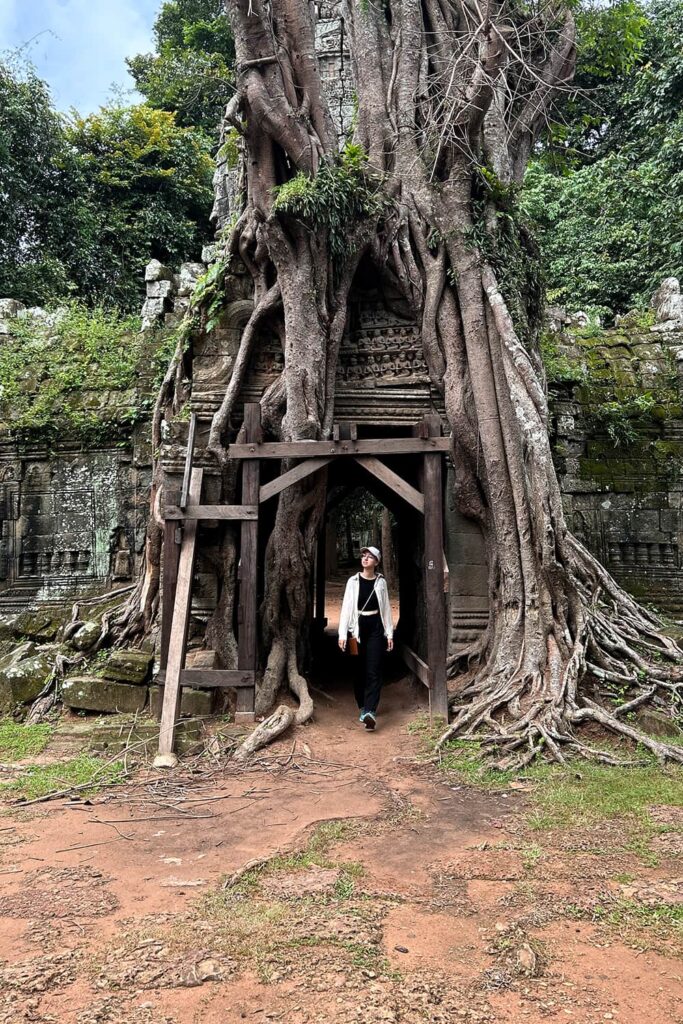
📍 East Mebon

The East Mebon Temple was built in the 10th century by Rajendravarman II. Similar to Neak Pean, the East Mebon was built on an artificial island inside a baray, namely the East Baray. However, today the latter does not hold water anymore.
- Highlight: The East Mebon Temple is home to beautiful Elephant statues that are quite well preserved! Also, since the temple layout imitates a mountain (as did a lot of the earlier temples) you can climb to the top platform of the temple and enjoy the view over the surrounding forest.
- Worth a visit? Yes, we think the East Mebon is worth a visit! It is quite different from the previous temples on the Grand Circuit. However, if you decide to visit Pre Rup (see next section) then the East Mebon is not a must since they are so similar.
📍 Pre Rup
Pre Rup was built a few years after East Mebon as the state temple of Rajendravarman II. Since both temples were built with a similar layout by the same king, they are sometimes called the ‘twin temples’.
- Highlight: Same as the East Mebon temple, Pre Rup also has a mountain-shaped/pyramid layout, with the difference that Pre Rup is slightly higher!
- Worth a visit? We would say, visit one or the other. You can of course visit both, however chances are that by the time you reach this part of the Grand Circuit you will have seen quite a number of awesome temples already so we personally think that one or the other is enough.

📍 Srah Srang

Srah Srang is a baray that is located opposite of Banteay Kdei, right at the road section where the Small and Grand Circuit merge once more. The baray was built in the 10th century by Rajendravarman II, same as the East Mebon and Pre Rup temples.
- Highlight: On the west side you will find a small platform with a set of stairs, which functions beautifully as a viewing platform for the baray!
- Worth a visit? A quick pit stop at the baray viewing platform can be a nice change of scenery. It is however definitely not a must.
❓ But, what circuit should you choose?
As you might have guessed, the Small Circuit is pretty popular among visitors that prefer to visit only the most popular temples and are a bit more pressed for time.
Therefore, the Small Circuit is very often done as a day trip, starting in Angkor Wat at sunrise before making your way through the temples and ruins alongside the circuit over the course of the day.
- This has the advantage that you are able to see the most popular sites in only one day.
- The big disadvantage is however, that you are constantly moving around with the crowd of day trippers that have the same schedule as you.


The Grand Circuit usually enters the picture when visitors plan to explore Angkor for more than one day.
We would recommend exploring Angkor Archaeological Park for at least 2, ideally 3 days. Choose the best of both circuits and ask your tuk-tuk driver for his recommendations when doing so. Usually they have a pretty good idea of what temples not to skip, when the crowds hit what temple and how to navigate around that😉. That’s how we created our route as well!
Need more inspo? Find out the exact route we took to see the best of both circuits in our Siem Reap Itinerary!
Seeing Angkor Wat at sunrise: Worth it or not?
Now, your first thought when reading this question might be: ‘Of course it is worth it! Why else would it be on everyone’s bucket list?!’. Well, yes and no.
For us personally, standing there and seeing the sun slowly rise behind Angkor Wat was so worth it. The fact alone that this experience was something we really wanted to do for so long and then finally being able to actually stand there and see it made it a really magical experience we were super grateful to have!
However, we also overheard a number of people around us that were like: ‘That was underwhelming’, or, ‘Did we really get up at 4 a.m. for this?’. Granted, we were there during rainy season and, to their credit, sunrises are supposedly more spectacular during dry season.
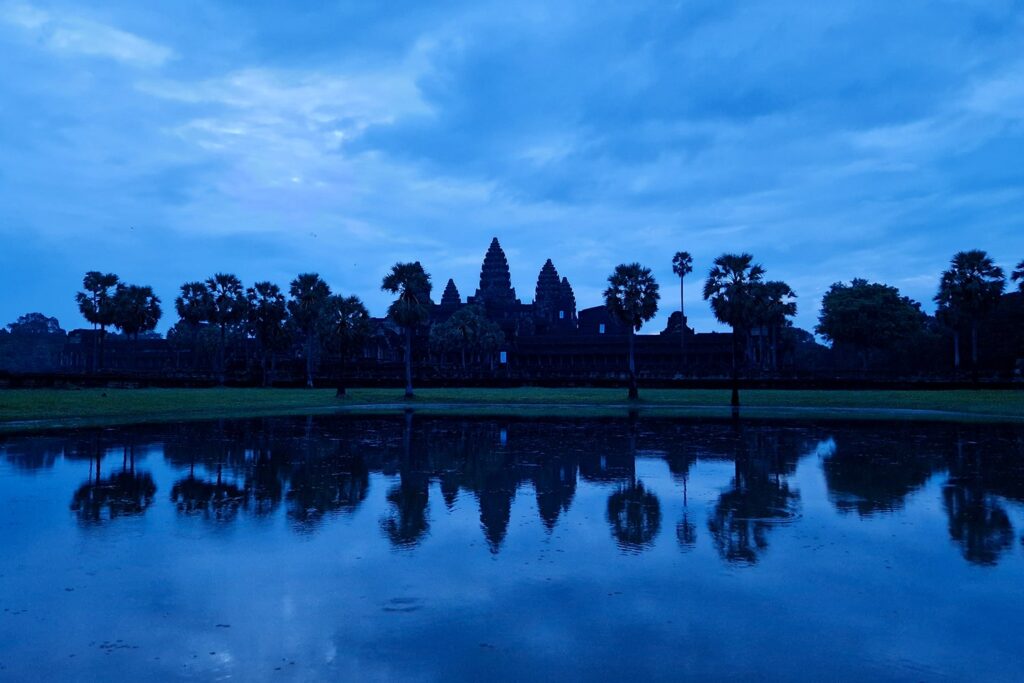

This however does not change the fact that they did not really seem to be there because they really wanted to be there. It was more of a ‘everyone does it so I guess we’ll tick that box as well’ situation. Also I’ll add that those were the first people to leave the moment the sky turned light, even before the sun ACTUALLY started to rise behind Angkor Wat🤷🏻. So, there’s that.
I guess what I am trying to say is: At the end of the day, even the sunrise at Angkor Wat is ‘just’ a sunrise. Whether this is a meaningful experience relies on you. So ask yourself the following question: Do I really want to see the sun rise behind Angkor Wat or am I just doing it because I think I have to tick a box? Make your decision based on your answer (plus maybe the season)😉.


Essential Items to bring when visiting Angkor
Truthfully, we would not recommend you bring too much when exploring Angkor. Less items = less to carry around + less to worry about! Only pack a few essentials and you should be good to go!
👜 Crossbody Bag. Perfect for day excursions and only bringing the essentials.
🎟️ Angkor Pass. Don't forget your entry ticket! You'll have to present it every day when asked at the checkpoint.
💧 Water. Bring something to drink. It is going to be hot and you will likely explore Angkor for hours each day. Note: Our tuk-tuk driver provided water for us so we didn't have to bring any.
🦟 Mosquito Spray. All temples are surrounded by forest, some are even located inside said forest and there are quite a few water features. So, make sure bring something to keep mosquitos away!
👒 Sunhat and sunscreen. While you will spend a lot of time in forested areas, some temples have no shade and you'll be exposed to direct sunlight when exploring them.
📷 Camera. Be it on your phone or a camera, be prepared to take a lot of pictures when exploring Angkor!
Scams to watch out for in Angkor
When many tourists gather in one location, scams are unfortunately often not very far either. And, this is definitely also true for Angkor Wat and the whole Angkor Archaeological Park in general.
In this section we want to quickly go over a few scams that might come your way while exploring Angkor. This list is not complete however, it is more-so meant to give you an idea of the nature of common scams here. If you know what to watch out for, it is actually fairly easy to avoid them too.
Photography Scam
Individuals walking around with a camera who will at first pretend like they are taking random pictures of the temple. Then they will eventually approach you and ask whether they should take your picture too.
If you say yes there is a high chance you will be overcharged for a very low-quality picture. We encountered this scam at Bayon and Angkor Wat. Vehemently decline their offer and they will leave you alone.

Fake Guides, Monks and Guards
When walking up to Angkor Wat fake guides will come up to you and offer to be your guide around the temple. They will even wear a uniform, but don’t be fooled. They are not licensed guides. The latter have to undergo a multi-months training to get their license. The fake guides will most likely charge you like a licensed one though😉.


Again, simply decline their offer and walk away. There is a chance that they are quite persistent so stay firm. If you truly want a licensed guide, your best bet is to book a tour in advance, be it a group or private tour.
Apparently there are also fake monks and fake guards around. Luckily we did not encounter any of those. This might be one more advantage of getting a good tuk-tuk driver to take you around: even though you can’t tell the fake guards from the real ones, your driver will know. In any case, keep in mind: if you have the Angkor Pass, there is no such thing as a temple where you need to pay extra to get in!

Very persistent vendors
These ones you will mostly encounter at rest stops e.g. restaurants, parking spots and such. They will try to sell you various souvenirs and goods, of course way overcharged, you know, the typical stuff😉.
Sometimes even children will come up to you and beg or try to sell stuff. Personally, we only encountered this in Phnom Penh, however know that it is something that is not uncommon in other places in Cambodia as well. You should never interact with them though, no matter how much pity you may have!
If child vendors/beggars are more successful than adults, more children may be taken out of school to go beg instead. To prevent that, you should always only buy from adults!
Final Thoughts on visiting Angkor Wat and the Angkor Archaeological Park
Angkor Wat is one of those places that most travellers have on their bucket list! And rightly so. It is a stunning location and the whole Angkor complex is filled with history, nature and a little mystery.

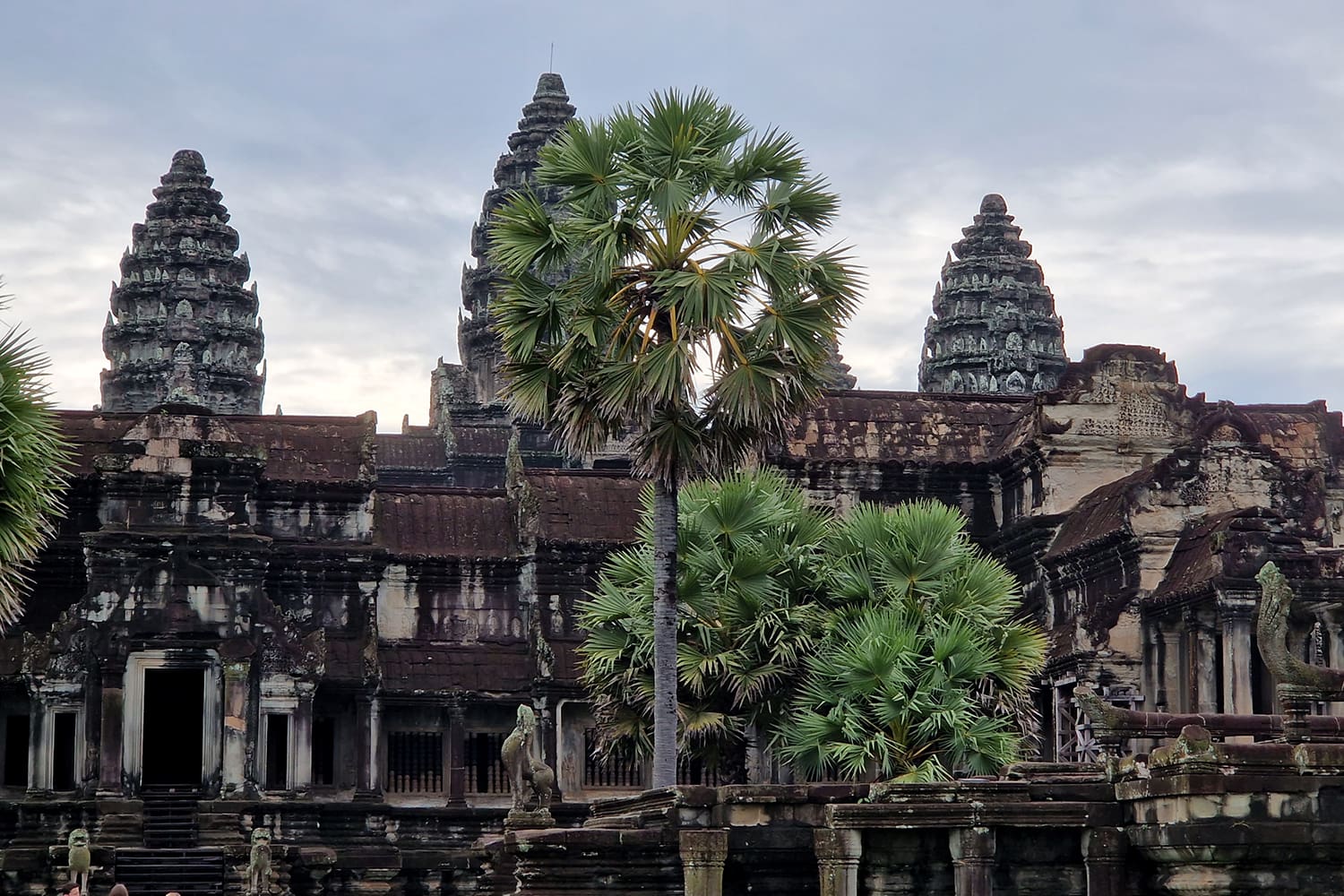
If you ever wanted to know what it would be like to wander around centuries-old ruins and temples that are overgrown with the most stunning vegetation, then Angkor is definitely the place for you. It was one of our Cambodia highlights and we agree that it is an absolute MUST-SEE when in Cambodia!
In this guide we went over all the details you should be considering when planning your trip to Angkor. From where to purchase your tickets, different sightseeing routes and their temples to our best tips on how to get around, avoid scams and what essentials to bring when exploring!
If you ever have other questions, feel free to drop them in the comments below. And, as always, happy travels!

